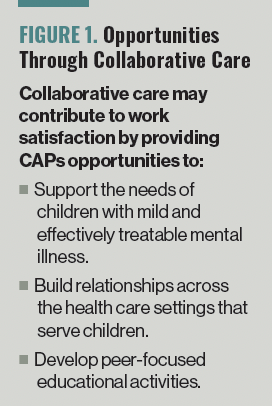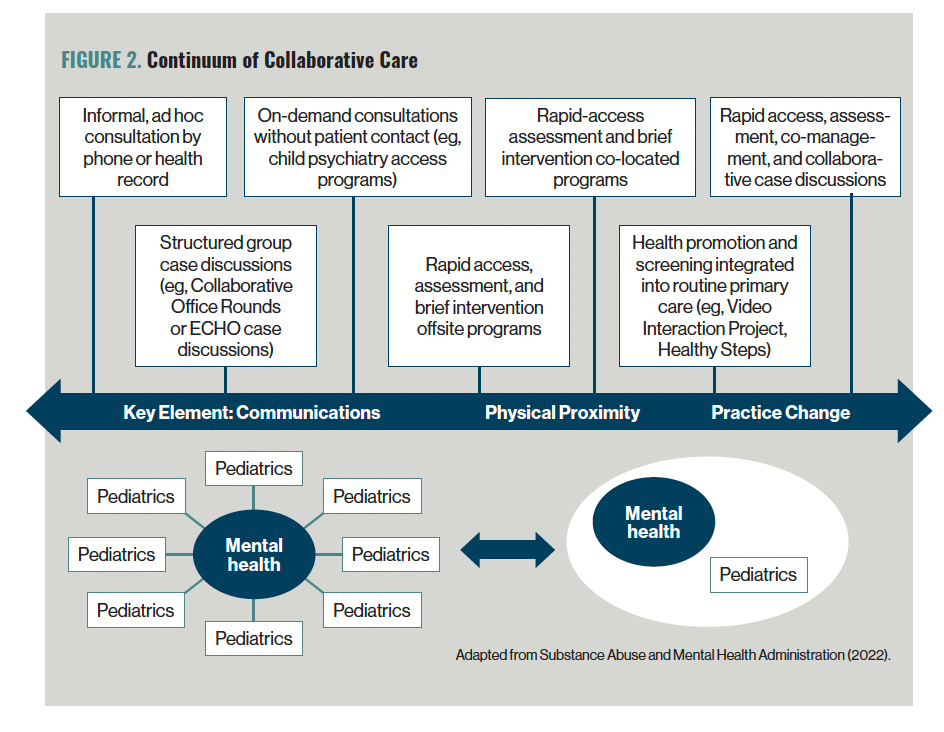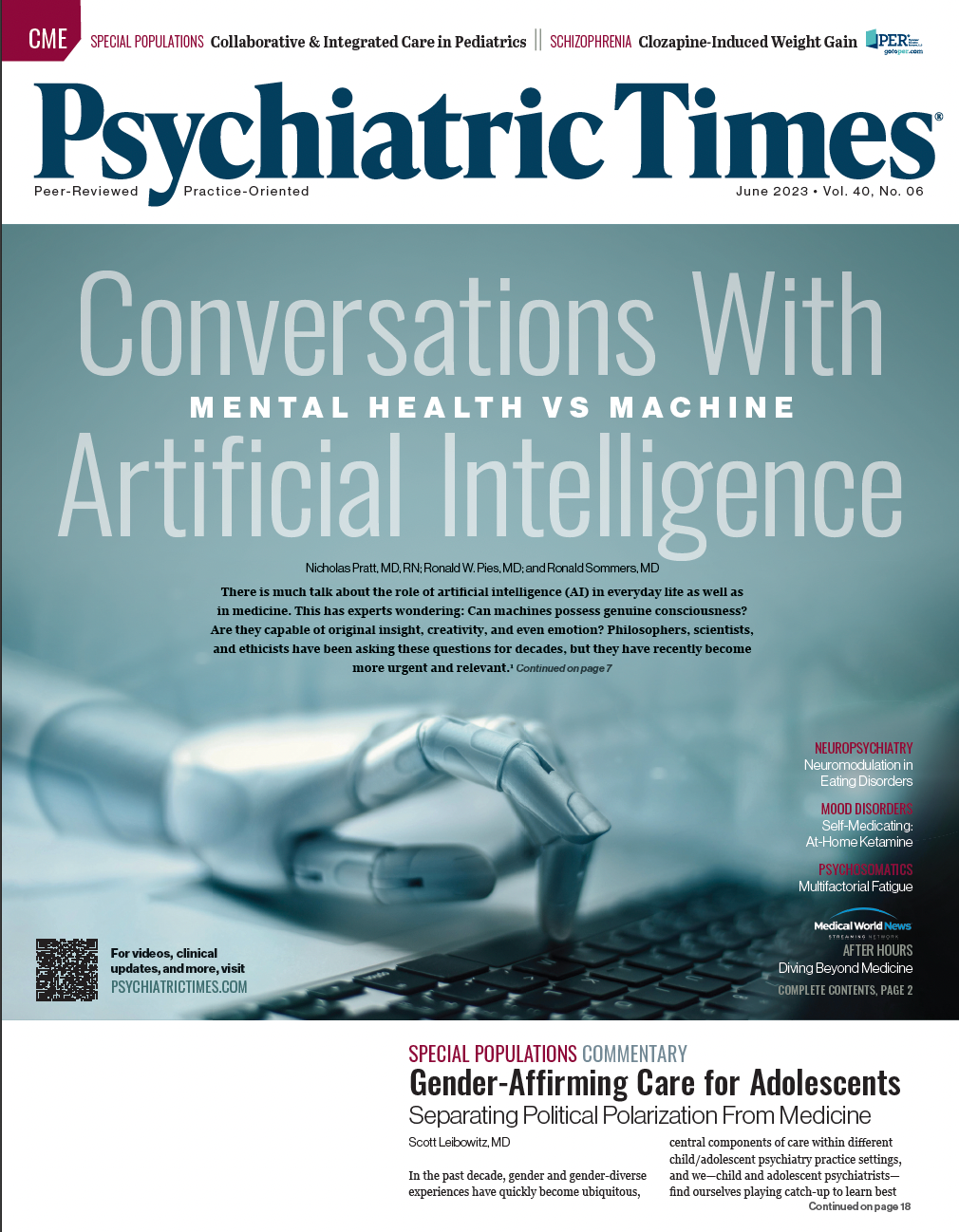CME
Article
Psychiatric Times
Collaborative and Integrated Care in Pediatrics: Part of the Solution to the Child Mental Health Crisis
Author(s):
In this CME, learn more about implementing formal or informal collaboration with the primary care clinicians with whom you share care of your child patients.
fizkes/AdobeStock

CATEGORY 1 CME
Premiere Date: June 20, 2023
Expiration Date: December 20, 2024
This activity offers CE credits for:
1. Physicians (CME)
2. Other
All other clinicians either will receive a CME Attendance Certificate or may choose any of the types of CE credit being offered.
ACTIVITY GOAL
The goal of this activity is to learn about implementing formal or informal collaboration with the primary care clinicians with whom you share care.
LEARNING OBJECTIVES
1. Understand the rationale for collaborative care models.
2. Understand key elements of collaborative care models that enable successful treatment.
TARGET AUDIENCE
This accredited continuing education (CE) activity is intended for psychiatrists, psychologists, primary care physicians, physician assistants, nurse practitioners, and other health care professionals seeking to improve the care of patients with mental health disorders.
ACCREDITATION/CREDIT DESIGNATION/FINANCIAL SUPPORT
This activity has been planned and implemented in accordance with the accreditation requirements and policies of the Accreditation Council for Continuing Medical Education (ACCME) through the joint providership of Physicians’ Education Resource®, LLC, and Psychiatric Times™. Physicians’ Education Resource®, LLC, is accredited by the ACCME to provide continuing medical education for physicians.
Physicians’ Education Resource®, LLC, designates this enduring material for a maximum of 1.5 AMA PRA Category 1 Credits™. Physicians should claim only the credit commensurate with the extent of their participation in the activity.
This activity is funded entirely by Physicians’ Education Resource®, LLC. No commercial support was received.
OFF-LABEL DISCLOSURE/DISCLAIMER
This accredited CE activity may or may not discuss investigational, unapproved, or off-label use of drugs. Participants are advised to consult prescribing information for any products discussed. The information provided in this accredited CE activity is for continuing medical education purposes only and is not meant to substitute for the independent clinical judgment of a physician relative to diagnostic or treatment options for a specific patient’s medical condition. The opinions expressed in the content are solely those of the individual faculty members and do not reflect those of Physicians’ Education Resource®, LLC.
FACULTY, STAFF, AND PLANNERS’ DISCLOSURES AND CONFLICT OF INTEREST (COI) MITIGATION
None of the staff of Physicians’ Education Resource®, LLC, or Psychiatric Times™ or the planners of this educational activity have relevant financial relationship(s) to disclose with ineligible companies whose primary business is producing, marketing, selling, reselling, or distributing health care products used by or on patients. Drs Gleason and Fallucco note nothing to disclose regarding this article.
For content-related questions, email us at PTEditor@mmhgroup.com. For questions concerning the accreditation of this CE activity or how to claim credit, please contact info@gotoper.com and include “Collaborative and Integrated Care in Pediatrics: Part of the Solution to the Child Mental Health Crisis” in the subject line.
HOW TO CLAIM CREDIT
Once you have read the article, please use the following URL to evaluate and request credit: https://education.gotoper.com/activity/ptcme23june. If you do not already have an account with Physicians’ Education Resource®, LLC, you will be prompted to create one. You must have an account to evaluate and request credit for this activity.
Leading child health organizations declared a national state of emergency for child mental health in October 2021 in the context of the COVID-19 public health crisis.1 The public health crisis exacerbated longstanding problems with inadequate access to quality child mental health care. Even before 2020, most pediatric mental health concerns and psychiatric disorders went untreated; only a small minority of children received specialty mental health care, and geographic and racial disparities significantly affected access.2-5 The critical child psychiatric clinician workforce shortage is a major barrier to access as well; about 70% of US counties have no child and adolescent psychiatrists (CAPs).4
Out of necessity, primary care serves as the de facto mental health system, providing a substantial proportion of mental health care for children in the United States.6-9 Unfortunately, the current pediatric residency training requirements do not mandate psychiatry clinical rotations (although expansion is proposed), and only one-third of graduating residents report high competence in mental health assessment and even fewer in treatment.10-12 Thus, although primary care clinicians (PCCs) and the primary care setting have many strengths—trusting, longitudinal family relationships; minimal stigma; and a developmental perspective—they lack the expertise and skills needed to properly address psychiatric and mental health issues.9
Figure 1. Opportunities Through Collaborative Care

Collaborative care models offer opportunities to combine the unique expertise of CAPs and PCCs (Figure 1).13 The Substance Abuse and Mental Health Services Administration categorizes models into 3 groups, with key elements of (1) communication, (2) physical proximity of the collaborating professionals, and (3) practice change or transformation.14 These models range from informal communication on a case-by-case basis to fully integrated, co-located, team-based care. Although the strongest evidence supports integrated approaches, in part because of the ease of studying self-contained systems, local resources, geography, and readiness for change may determine the best model for a community. The full continuum of collaborative care can be seen in Figure 2.
Figure 2. Continuum of Collaborative Care

Communication-Based Models
Case-based discussion models can serve large geographic areas and multiple practices, and do not interfere with the routine workflow. The most commonly used model is traditional ad hoc: provider-provider collaboration around shared patient care. Ideally, the CAP can access pediatric records through a shared chart or records request, and they send communication back to the PCC in writing or by telephone. Optimally, this communication includes a clearly documented diagnosis; a treatment plan, including specific medication doses and planned follow-up; elements of the informed consent, discussed with patient; and signs of deterioration that would warrant faster return to the CAP. Through shared patients, some CAPs serve as informal consultants to the pediatric colleagues in their community and vice versa. This communication can be facilitated by the clinicians sharing after-hours contact numbers with each other so that front-desk closure does not limit collaboration.
The best studied example of a communication-based model of collaboration is Project ECHO (Extension for Community Health Care), a telehealth-based model developed to support PCCs in caring for rural patients with liver disease. It has been expanded with well-established empiric support and a growing evidence base in child mental health.15,16 In a regularly scheduled ECHO meeting, a member of an expert team presents a brief didactic, and a PCC participant presents a case for feedback from peers and the hub.15 The model relies on an “all teach, all learn” principle of shared learning in which the PCCs learn from both their peers as well as the established content experts. Another example of communication-focused consultation is the Human Resources Services Administration–funded Collaborative Office Rounds model, in which a CAP and PCC together lead informal case-based discussions, traditionally in person.17
On-Demand Consultation
On-demand consultation models apply a population health approach to collaborative care and are well suited for large geographic areas. Massachusetts was the first state to offer phone consultation allowing PCCs to speak to a CAP in real time about specific clinical questions.18 Now, 43 states and 6 tribal nations and territories have similar child mental health access programs.19 These programs offer real-time phone consultations, with innovations that include:
- Expanded teams (eg, other licensed mental health professionals, care navigators)
- Opportunities for education, including ECHOs and care guides
- New consultee populations (educational or home visiting professionals)
- Topic-focused consultation (eg, peripartum mental health, substance use, autism spectrum disorders)
These programs report high PCC satisfaction, as well as ongoing learning, practice change, and application of the skills learned in consultation with other patients.13 Anecdotally, psychiatrists participating in these models have the opportunity to build relationships in their community, hone their teaching skills through consultation and didactic activities, and participate in the care of children with a range of presentations and acuity (including mild, treatment-responsive symptoms). They also often enjoy balancing consultation with other more traditional child psychiatry roles. Hilt and colleagues have reported cost savings in the preschool population and prescription pattern changes consistent with best practices (eg, less dosing outside of recommended ranges and fewer young children on medications).20
Offsite Consultation Models
Offsite consultation and training models provide rapid access to an assessment and brief intervention for youth with mild to moderate symptoms. After the patient has been stabilized, the PCC resumes care. Offsite consultation models can support small groups of practices, provide rapid access to patients with mild to moderate symptoms, and reduce referrals to specialty services. One example, the Center for Collaborative Care, has shown high PCC satisfaction, retention of 80% of patients in primary care, and improved access and quality of care, even 2 years later.21 Nearly all CAPs (89%) who participated in this model reported that it improved their collaboration skills with pediatricians and that they enjoyed practicing in this model.21
Hybrid Models
Many smaller programs tailor collaborative care to the specific needs of a community. For example, in Louisiana and other states, Project LAUNCH (Linking Actions for Unmet Needs in Children’s Health) applied a mixed consultation model that included both onsite consultation by a master’s-level clinician (1 day a week per practice) and offsite consultation by a CAP. The model was associated with improved provider-reported ability to meet mental health needs (with 49% to 80% describing an ability to meet young children’s mental health needs) and a modest but statistically significant utilization of recommended clinical strategies, like screening and addressing caregiver mental health.22
Co-Located Models
In co-located models of care, mental health professionals see patients in the primary care setting; they may offer specific interventions and can be available for warm handoffs or on-demand consults. This model requires dedicated resources, but it offers timely access, reduced logistical barriers for families, and variable disruption of medical home workflows. The models vary widely, with a range of clinicians and interventions offered.
One example shows that implementation of an evidence-based parent management training model shows promise in addressing children’s disruptive behavior symptoms.23 Another individual treatment model, Doctor-Office Collaborative Care—one of the most rigorously studied—has shown improved referral success and clinical outcomes, as well as cost savings over time.24 However, despite promising models, funding and dissemination remain a general challenge for co-located collaboration.13
Integrated Care
Integrated care combines mental health care with a primary care practice and depends on practice transformation. In the best-studied integrated care models, a PCC and clinician or case manager collaborate onsite and review cases with a CAP, often offsite. This model supports a stepped-care approach of screening, brief therapeutic interventions, and psychiatric care. It has been extensively studied in adults, but a growing literature demonstrates positive impact of an integrated team approach in children and adolescents.25 Other models, like HealthySteps and the Video Interaction Project, integrate a mental health professional or paraprofessional into routine care to support families and promote mental wellness.26,27 Although effective, many of the new supports are not reimbursable in traditional billing models.
Clinical Vignette
“Jessie,” a girl aged 8 years with attention-deficit/hyperactivity disorder (ADHD)-combined type on extended-release methylphenidate chewable 10 mg, is referred by her PCC for “meltdowns and sleep issues.” Jessie has daily 10- to 20-minute “meltdowns” during which she swings her arms, kicks, and screams; they are triggered when she is frustrated. Jessie also has trouble sleeping alone. She has been in therapy for 1 year with minimal improvement.
PCC refers patient to local community CAP
The PCC feels that Jessie probably has anxiety, but they are not comfortable starting her on a selective serotonin reuptake inhibitor (SSRI). The CAP sees Jessie 3 months later.
After seeing the patient, the CAP tries calling the PCC after hours and gets their answering service, so they send the consultation note documenting impression of generalized anxiety disorder and a plan to start an SSRI. The PCC then decides to focus their CME activity on child psychiatry to build a knowledge base.
PCC calls phone consultation line
The CAP validates that these episodes seem like more than what would be expected with typical ADHD, and they suggest using the Screen for Child Anxiety-Related Disorders (SCARED) to check for anxiety and asking more about the content of the therapy.
The CAP provides guidance about wording to explore Jessie’s mood and anxiety symptoms. The CAP learns that the PCC knows that Jessie’s family members also have anxiety and that her father, who is in the military, was recently deployed to an unknown country.
The CAP provides an outline of recommendation for SSRI for therapy-resistant anxiety and invites the PCC to call back for additional support after further assessment.
Co-located/Integrated care
With family consent, the PCC invites the co-located clinician into the room for a quick consult. The CAP suggests using an anxiety screen now and helps the PCC interpret the positive screen. The PCC comes back into the room and hears how the CAP asked Jessie about her anxiety, which Jessie endorsed strongly, and about suicide, which she denied.
The team recommends an SSRI to Jessie’s family and a care conference with the therapist, who is also treating Jessie’s siblings. The PCC starts the SSRI and Jessie is scheduled to follow-up with the CAP within 2 weeks.
Concluding Thoughts
Although the specific models vary, 2 principles underlie all collaborative care models:
1. Mental health is an integral part of pediatric health.
2. Primary care models cannot meet children’s needs without the support of psychiatric clinicians.
The opportunities for CAPs to participate in collaborative care models abound. The well-being of children requires that we allocate some of the new mental health federal funding to support innovative care delivery implementation and evaluation.
Dr Gleason is a pediatrician and child and adolescent psychiatrist. She is division director of child and adolescent psychiatry at Eastern Virginia Medical School and vice chief of mental health at Children’s Hospital of the King’s Daughters. Dr Fallucco is an attending child and adolescent psychiatrist in the Integrated Mental Health Clinic at the Children’s Hospital of the King’s Daughters.
References
1. AAP-AACAP-CHA declaration of a national emergency in child and adolescent mental health. American Academy of Pediatrics. Updated October 19, 2021. Accessed March 27, 2023. https://www.aap.org/en/advocacy/child-and-adolescent-healthy-mental-development/aap-aacap-cha-declaration-of-a-national-emergency-in-child-and-adolescent-mental-health/
2. Ghandour RM, Sherman LJ, Vladutiu CJ, et al. Prevalence and treatment of depression, anxiety, and conduct problems in US children. J Pediatr. 2019;206:256-267.e3.
3. Whitney DG, Peterson MD. US national and state-level prevalence of mental health disorders and disparities of mental health care use in children. JAMA Pediatr. 2019;173(4):389-391.
4. McBain RK, Kofner A, Stein BD, et al. Growth and distribution of child psychiatrists in the United States: 2007-2016. Pediatrics. 2019;144(6):e20191576.
5. Hoffmann JA, Alegría M, Alvarez K, et al. Disparities in pediatric mental and behavioral health conditions. Pediatrics. 2022;150(4):e2022058227.
6. Olfson M, Blanco C, Wang S, et al. National trends in the mental health care of children, adolescents, and adults by office-based physicians. JAMA Psychiatry. 2014;71(1):81-90.
7. Anderson LE, Chen ML, Perrin JM, Van Cleave J. Outpatient visits and medication prescribing for US children with mental health conditions. Pediatrics. 2015;136(5):e1178-e1185.
8. Regier DA, Goldberg ID, Taube CA. The de facto US mental health services system: a public health perspective. Arch Gen Psychiatry. 1978;35(6):685-693.
9. Green CM, Meschan Foy J, Earls MF; Committee on Psychosocial Aspects of Child and Family Health, Mental Health Leadership Work Group. Achieving the pediatric mental health competencies. Pediatrics. 2019;144(5):e20192758.
10. ACGME program requirements for graduate medical education in pediatrics. Accreditation Council for Graduate Medical Education. Revised July 12, 2022; further updated. Accessed March 27, 2023. https://www.acgme.org/globalassets/pfassets/reviewandcomment/320_pediatrics_rc_022023.pdf
11. ACGME program requirements for graduate medical education in pediatrics. Accreditation Council for Graduate Medical Education. Revised July 12, 2022. Accessed March 27, 2023. https://www.acgme.org/globalassets/pfassets/programrequirements/320_pediatrics_2022.pdf
12. Green C, Leyenaar JK, Turner AL, Leslie LK. Competency of future pediatricians caring for children with behavioral and mental health problems. Pediatrics. 2020;146(1):e20192884.
13. Schlesinger A, Sengupta S, Marx L, et al; American Academy of Child and Adolescent Psychiatry (AACAP) Committee on Collaborative and Integrated Care and AACAP Committee on Quality Issues. Clinical update: collaborative mental health care for children and adolescents in pediatric primary care. J Am Acad Child Adolesc Psychiatry. 2023;62(2):91-119.
14. Six levels of collaboration/integration: framework. Substance Abuse and Mental Health Services Administration – Health Resources and Services Administration Center for Integrated Health Solutions. https://www.thenationalcouncil.org/wp-content/uploads/2020/01/CIHS_Framework_Final_charts.pdf?daf=375ateTbd56
15. Harrison JN, Steinberg J, Wilms Floet AML, et al. Addressing pediatric developmental and mental health in primary care using tele-education. Clinical Pediatr (Phila). 2022;61(1):46-55.
16. Hostutler CA, Valleru J, Maciejewski HM, et al. Improving pediatrician’s behavioral health competencies through the Project ECHO teleconsultation model. Clin Pediatr (Phila). 2020;59(12):1049-1057.
17. Sajady M, Borman-Shoap E, Murray KE, et al. How to strengthen PCPs’ mental health training. Contemporary Pediatrics. 2019;36(11):38-40.
18. Sarvet B, Gold J, Bostic JQ, et al. Improving access to mental health care for children: the Massachusetts Child Psychiatry Access Project. Pediatrics. 2010;126(6):1191-1200.
19. Child psychiatry access programs in the United States. National Network of Child Psychiatry Access Programs. Revised March 2022. Accessed March 27, 2023. https://www.nncpap.org/map
20. Barclay RP, Penfold RB, Sullivan D, et al. Decrease in statewide antipsychotic prescribing after implementation of child and adolescent psychiatry consultation services. Health Serv Res. 2017;52(2):561-578.
21. Fallucco EM, Landy RE, Leung K, Robertson Blackmore E. Child psychiatry consultation clinic for pediatricians: long-term outcomes. Clinical Pediatr (Phila). 2021;60(8):350-362.
22. Gleason M-M. Going where the children are: early childhood consultation in Louisiana. J Amer Acad Child Adolesc Psychiat. 2017;56(10 Suppl):S105.
23. Perrin EC, Sheldrick RC, McMenamy JM, et al. Improving parenting skills for families of young children in pediatric settings: a randomized clinical trial. JAMA Pediatr. 2014;168(1):16-24.
24. Yu H, Kolko DJ, Torres E. Collaborative mental health care for pediatric behavior disorders in primary care: does it reduce mental health care costs? Fam Syst Health. 2017;35(1):46-57.
25. Asarnow J, Rozenman M, Wiblin J, Zeltzer L. Integrated medical-behavioral care compared with usual primary care for child and adolescent behavioral health: a meta-analysis. JAMA Pediatr. 2015;169(10):929-937.
26. Ammerman RT, Herbst R, Mara CA, et al. Integrated behavioral health increases well-child visits and immunizations in the first year. J Pediatr Psychol. 2022;47(3):360-369.
27. Brockmeyer Cates C, Weisleder A, Dreyer BP, et al. Leveraging healthcare to promote responsive parenting: impacts of the Video Interaction Project on parenting stress. J Child Fam Stud. 2016;25(3):827-835.

Newsletter
Receive trusted psychiatric news, expert analysis, and clinical insights — subscribe today to support your practice and your patients.






